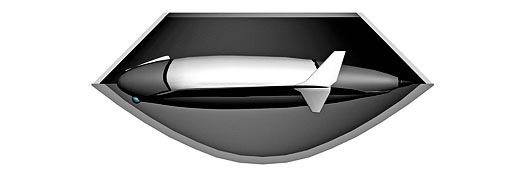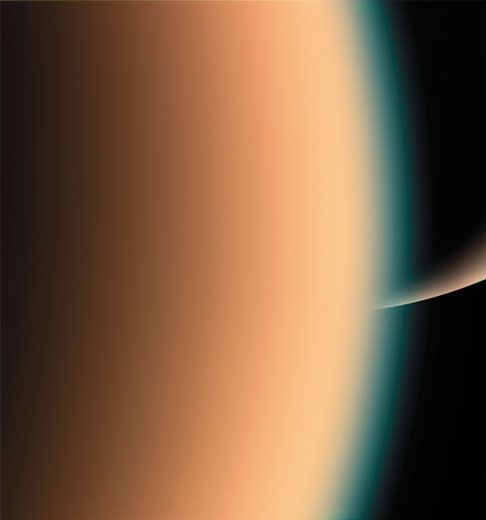Titan Air
Saturn’s mysterious moon may have airplanes in its future.
/https://tf-cmsv2-smithsonianmag-media.s3.amazonaws.com/filer/Titan_Air_FLASH.jpg)
In his 30-odd years designing aircraft, Rick Foch has, believe it or not, seen trickier problems than this one. His shop at the U.S. Naval Research Laboratory in Washington, D.C., has invented dozens of unmanned aerial vehicles of all shapes and dimensions, from a UAV that folds up in a Marine’s backpack (Dragon Eye, 2000) to a small drone launched from a Predator (Finder, 2000) to a winged radar target that can withstand 10,000 Gs while being shot from a ship’s gun (FLYRT, 1991).
Foch understands the difficulty of sending a robot airplane to fly, with almost no human supervision, for a full year in an alien atmosphere nearly a billion miles away—around Saturn’s moon Titan. But it’s doable, he says. You want tough? Try designing an airplane for Mars. Foch has done that too.
Of all the worlds in our solar system, only a few have atmospheres that would allow winged flight: Titan, Venus, Mars, Earth, and the outer gas planets. Aerodynamically, Titan is by far the best place to fly airplanes. Ralph Lorenz, a planetary scientist at the Johns Hopkins University Applied Physics Laboratory near Baltimore, Maryland, who has made this exotic moon his object of study, calls it “an aviator’s paradise.” Never mind that it rains methane there, and is so cold that water turns hard as granite. Titan’s atmosphere is thick—four times as dense as Earth’s—and the pull of gravity is only one-seventh what it is here. That combination makes it ideal for generating aerodynamic lift, so flying on Titan takes far less power than a comparable flight on Earth.
Larry Lemke, an aerospace engineer at NASA’s Ames Research Center in Mountain View, California, started studying the problems of extraterrestrial flight in the 1980s. He well knew the terrible constraints that space engineers suffer every day—especially the tight limitations on power, mass, and volume. What he needed was a collaborator from the aeronautics world who wasn’t fazed by those requirements. “When I got into studying Mars airplanes, 20 years ago or so, I looked around to figure out who I would want to work with,” Lemke says. “I understood all the space systems, and am an aeronautical engineer, so I knew how to design airplanes. But the tricky part was how to design airplanes that have strange configurations and—oh, by the way—need to deploy in midair and fly away. So I went around to all the usual suspects—the Skunk Works, Burt Rutan, AeroVironment, and so forth. They’re all very, very competent airframe designers and builders, but almost none of them had ever built a folding airplane. And by that time, Rick Foch had already built eight or ten. All the vectors pointed to him.”
Lemke and Foch have been collaborating, off and on, ever since. Their most recent Mars airplane concept, called Matador, won enough NASA R&D funding to advance to wind tunnel tests in 2006. Now they’re working together on a proposal for a Titan airplane called AVIATR—Aerial Vehicle for In-situ and Airborne Titan Reconnaissance—which scientists at Ames and other centers are pitching as a candidate for NASA’s next $425 million Discovery mission, scheduled to launch in 2016. If selected (the winner will be chosen in 2012 or 2013), it will be the first airplane built for another world.
Titan is more than just a convenient place to fly. It has become in recent years a prime destination for planetary scientists. It’s the only world we know of, beside our own, with lakes of liquid (in this case methane), and due to its abundance of organic chemicals, some researchers consider it the perfect laboratory for studying the origins of life. After the European Huygens lander touched down on the moon’s surface in 2005, scientists immediately started planning a return. “Everybody was instantly talking about mobility,” says Lemke. A winged vehicle could cover a lot more territory than a rover, so the advantages of flying are obvious. And on a moon perpetually covered by clouds, an airplane flying under the haze could “do the equivalent of satellite reconnaissance.” Hence, AVIATR.
Foch, whose title at NRL is Senior Scientist, Expendable Vehicles, takes the same approach to designing a Titan airplane that he would for a drone launched from a ship or Humvee: “We always start with the container.” AVIATR would travel to Saturn packed in a clamshell-like entry capsule, which upon arrival would parachute into Titan’s atmosphere. The clamshell’s heat-resistant bottom drops away, AVIATR is released, and the airplane noses into the airstream and levels off. Its speed at deployment is leisurely—a mere 25 mph. (A Mars airplane, by contrast, separates from its parachute at nearly the speed of sound, then has to unfold and begin flying in a matter of seconds. Lemke calls it the “death plunge.”)
To get enough lift in the thin air around Mars, airplanes require large wing areas, making them “diaphanous and fragile,” says Lemke. But for Titan’s dense atmosphere, an airplane can be as stubby and rugged as a C-130—which, Lemke points out, can fly through a hurricane. The latest iteration of the AVIATR design has a delta shape with a 11.4-foot wingspan, sized neatly for a 13-foot entry capsule. “Compared to a Mars airplane, it’s wonderful,” says Foch. “We don’t even have to fold the wings.”
Once released in the atmosphere, AVIATR would fly slow hawk-like circles over the Titan landscape, taking photos and spectra of the surface, which would remain in constant sunlight. Depending on the target, controllers on Earth could direct the airplane to fly at different altitudes, from a low of two miles (safely above the mountains) to a ceiling of almost nine, where icing becomes a risk.
The mission would last a year or more. The technology that makes such a long-duration flight possible is a new type of nuclear battery called an Advanced Stirling Radioisotope Generator, or ASRG, which NASA is developing for the 2016 Discovery launch. Lighter and more efficient than the plutonium batteries used on current planetary missions like Cassini, the ASRG would drive the airplane’s pusher propeller, power the instruments and communication antenna, and provide heat when the outside air is minus 350 degrees Fahrenheit.
At those ridiculous temperatures, you would expect materials to be a worry, but AVIATR will be made of fiberglass, the same stuff used to construct the containers that store liquid helium. Problem solved. Lemke and Foch say their biggest concern is the longevity of the electronics, actuators, motors, computers, and other small components. “No one’s ever built an airplane that can fly a year or two,” says Foch, because no one has had to. Reliability will be a must, and critical parts will need backups.
Turbulence is a minor concern; Titan’s air is obviously not as well understood as Earth’s. The only direct experience with the lower atmosphere that Lemke and Foch have to go on is Huygens’ parachute drop in 2005. The feeble sunlight on Titan doesn’t deliver much energy, so winds should be light, but just in case, the engineers are designing the airplane to be as inherently stable and self-correcting as possible. More than any airplane in history, AVIATR will be on its own.
Since NASA spacecraft operate so far from home, they’re designed so that if they lose orientation, they go into “safe mode”: Find Earth or some other recognizable target, lock onto it, and await instructions. AVIATR’s equivalent of a safe mode will be a Dutch roll—a steady side-to-side rocking that would prevent the airplane from going into a graveyard spiral down to Titan. The designers have come up with a modifier vane—a “unique feature of this airplane,” says Foch—that could pop up from the nose to add lateral stability if AVIATR’s autopilot fails.
Foch and Lemke plan to verify the effectiveness of the flight controls in wind tunnel and atmospheric tests before launch—if there is a launch. AVIATR will have to compete for the 2016 Discovery slot, which is sure to draw at least a dozen other clever, well-thought-out proposals.
Ralph Lorenz of the Applied Physics Lab loves the idea of flying around his favorite moon. He has even designed his own two-pound UAV, which he calls the Titan Bumblebee, for hovering over the surface. But for this Discovery round, he is part of a team proposing a different concept. Called TIME, for Titan Mare Explorer, it would land a floating spacecraft on one of the moon’s methane lakes. Lorenz thinks an airplane may well be included on some future multibillion-dollar expedition to Titan, but figures NASA might be nervous gambling an entire Discovery mission on its first extraterrestrial airplane—which some people still consider a pretty far-out concept.
Not Rick Foch and Larry Lemke, who have been quietly working that problem for years. AVIATR is probably their most advanced vehicle yet, and their best shot at moving beyond the prototype stage. And somewhere on Titan’s dim, frozen surface may be their Kitty Hawk.
/https://tf-cmsv2-smithsonianmag-media.s3.amazonaws.com/filer/Titan_Air_3_GALLERY.jpg)


